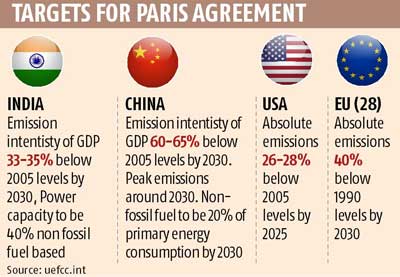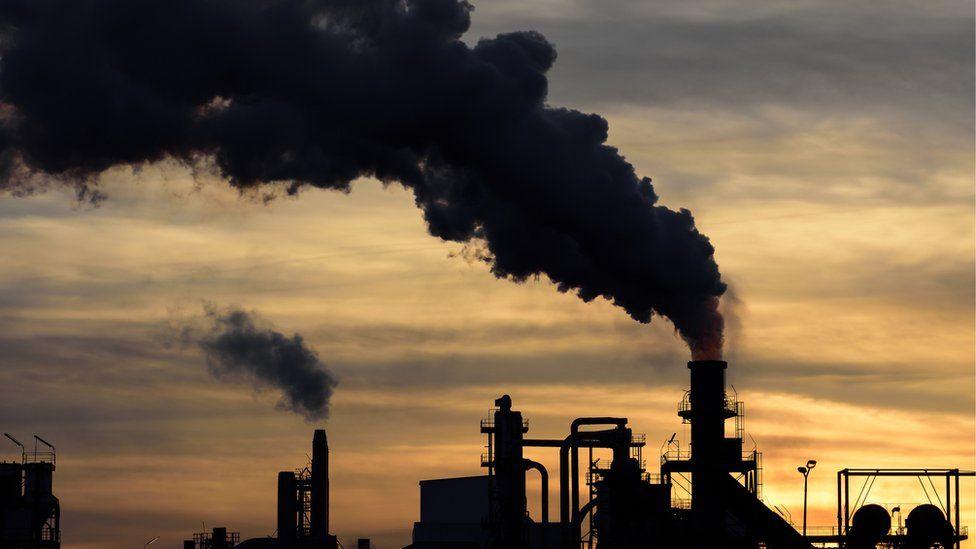India has successfully slashed its GDP emission intensity by 33% between 2005 and 2019, exceeding its target 11 years ahead of schedule. A government report, ‘The Third National Communication to the United Nations Framework Convention on Climate Change,’ outlines the nation’s substantial progress in decoupling economic growth from greenhouse gas emissions.
Decoupling Economic Growth and Emissions
- Despite a cumulative annual GDP growth rate of 7%, India’s emissions increased by only 4% per year during 2005-2019.
- This remarkable feat showcases India’s ability to achieve sustainable economic growth while curbing emissions.

Carbon Sink and Additional Achievements
- India created an additional carbon sink of 1.97 billion tonnes of CO2 equivalent during the same period.
- The country is on track to achieve its target of reducing GDP emission intensity by 45% by 2030, compared to 2005 levels.
Sector-wise Analysis
- The energy sector contributed the most to anthropogenic emissions (75.81%), followed by agriculture (13.44%), Industrial Process and Product Use (8.41%), and waste (2.34%).
- The Land Use, Land-Use Change, and Forestry (LULUCF) sector removed a significant 4,85,472 gigatonnes of carbon dioxide equivalent (GgCO2e) of emissions.
Global Leadership and Future Commitments
- Prime Minister Narendra Modi positioned India as a global climate leader, achieving NDC targets well ahead of schedule.
- India proposes to host the annual UN climate talks in 2028, showcasing its commitment to addressing climate change on the global stage.
International Comparisons
- India stands out among developing countries, submitting its third national communication with GHG inventory of 2019, showcasing more recent data compared to other nations like China (2014), Brazil (2016), South Africa (2017), and Saudi Arabia (2012).
Future Goals and Ambitions
- India aims to achieve 50% cumulative electric power installed capacity from non-fossil fuel-based energy resources by 2030.
- The country is committed to becoming a net-zero economy by 2070, highlighting its dedication to long-term sustainability.
COP28 Highlights
- Prime Minister Modi, at COP28, emphasized that India, with 17% of the world’s population, contributes less than 4% of global carbon emissions.
- He called out rich nations, stating that a small section of humanity has disproportionately exploited nature, with the entire world, especially those in the Global South, paying the price.
Important Questions Related in Exams
Q: How much did India reduce its GDP emission intensity between 2005 and 2019?
A: India successfully reduced its GDP emission intensity by an impressive 33% during the period from 2005 to 2019.
Q: What was the annual cumulative growth rate of India’s GDP during the same period?
A: Despite a robust cumulative annual growth rate of 7%, India managed to limit its emissions to an increase of only 4% per year between 2005 and 2019.
Q: What is the significance of the additional carbon sink created by India during this period?
A: India created an additional carbon sink of 1.97 billion tonnes of CO2 equivalent, showcasing its commitment to offsetting emissions through environmental initiatives.
Q: How does India’s emission intensity reduction compare to its future targets?
A: India is well on track to achieve its target of reducing GDP emission intensity by 45% by 2030 compared to the 2005 level, exceeding the goal by 11 years.
Q: Which sectors contribute the most to India’s anthropogenic emissions?
A: The energy sector takes the lead, accounting for 75.81% of India’s anthropogenic emissions, followed by agriculture (13.44%), Industrial Process and Product Use (8.41%), and waste (2.34%).
Q: What is the aim of India regarding its electric power installed capacity by 2030?
A: India aims to achieve 50% cumulative electric power installed capacity from non-fossil fuel-based energy resources by the year 2030.
Q: What are India’s commitments towards becoming a net-zero economy?
A: India has committed to becoming a net-zero economy by 2070, demonstrating a long-term dedication to sustainability and climate action.



 Ashwini Vaishnaw Inaugurates India’s 5...
Ashwini Vaishnaw Inaugurates India’s 5...
 Vriksharopan Abhiyan 2024 Launch in Dhan...
Vriksharopan Abhiyan 2024 Launch in Dhan...
 India's Installed Nuclear Power Capacity...
India's Installed Nuclear Power Capacity...
